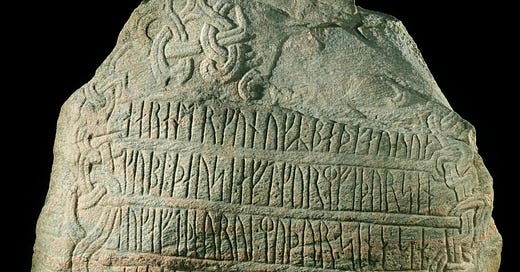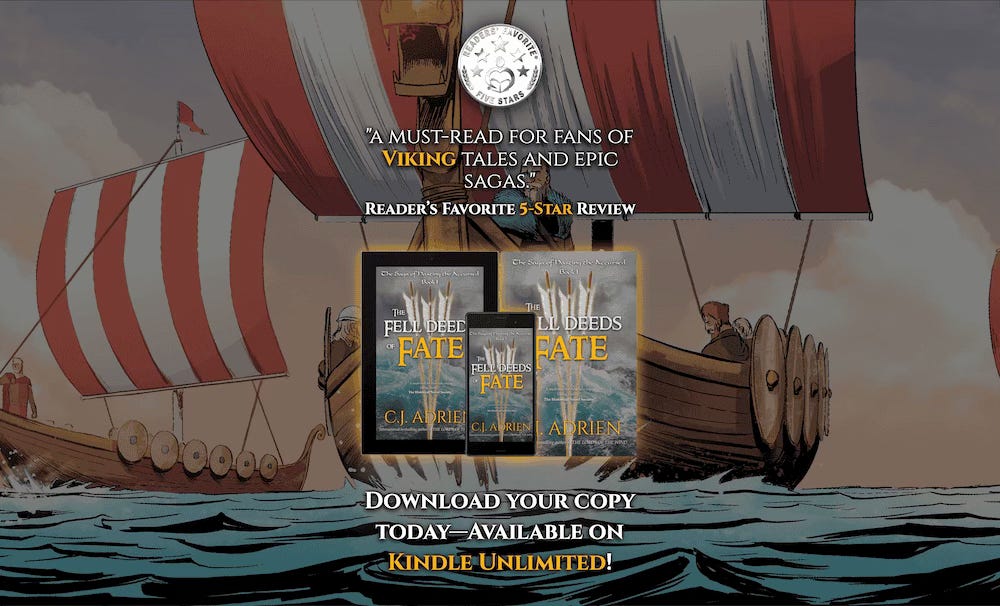The Jelling Stone Feud: Danes and Norwegians Spar Over Viking Heritage.
Are we witnessing the beginning of an academic Holmgang?
The Jelling stones, often called Denmark’s "birth certificate," are among the most treasured artifacts of the Viking Age. These monumental runestones, erected by King Gorm the Old and his son Harald Bluetooth in the 10th century, symbolize Denmark’s transition to Christianity and the unification of the kingdom. The stones hold UNESCO World Heritage status and are a point of immense national pride.
But a new theory from Norwegian archaeologist Håkon Glørstad has hurled a Viking Age axe into the narrative. He argues that one of the Jelling stones may not date to the Viking Age but was commissioned much later, during the 12th century. This claim has ignited outrage among Danish scholars, with runologist Michael Lerche Nielsen dismissing the idea as "absurd." As Danish and Norwegian academics spar over their heritage, will the debate over the Jelling Stones become more than an academic dispute?
The Norwegian Challenge: Håkon Glørstad’s Theory
Norwegian archaeologist Håkon Glørstad has questioned whether the large Jelling stone belongs to the Viking Age. He proposes that instead of being carved in the late 900s, the stone was commissioned in the 1100s as part of a medieval nation-building effort.
Glørstad’s argument is based on three observations:
Horizontal Text Orientation: Unlike most Viking Age runestones, which feature vertical text, the large Jelling stone’s inscription is horizontal. This style was more common in medieval inscriptions.
Stylistic Elements: The inscription's summary of King Harald’s achievements resembles 12th-century grave slabs rather than traditional Viking Age carvings.
Material and Iconography: The stone’s material and the depiction of a lion suggest influence from 12th-century European motifs, a time when such imagery was more typical among Norwegian and Danish monarchs.
Glørstad acknowledges that his theory challenges ingrained historical narratives but insists that reexamining well-established artifacts is essential for advancing archaeological research. He argues that history should not be treated as an unquestioned national myth but as a constantly evolving field of study.
The Danish Rebuttal: Michael Lerche Nielsen Fires Back
Danish runologist Michael Lerche Nielsen has disputed Glørstad’s claims. His response was direct and dismissive, calling the theory "absurd from a runological perspective."
Nielsen presents three strong counterarguments:
Runic Language Analysis: The inscription’s language is unmistakable from the Viking Age. Linguistic shifts between the Viking Age and the 12th century make it unlikely that the stone was created later.
Historical Context: While Glørstad cites the horizontal text orientation as evidence of a later date, recent discoveries show that Viking Age runestones with horizontal inscriptions exist.
Archaeological Evidence: Decades of scholarship have placed the Jelling Stones in the 10th century. The site’s significance and role in Harald Bluetooth’s Christianization of Denmark align with its Viking Age dating.
For Nielsen, the idea that a later bishop could have ordered the Jelling Stone’s creation is historically inaccurate; it undermines the ingrained archaeological and linguistic research that has long validated the stone’s Viking origins.
A Rekindled Nordic Rivalry
To the bemusement of some (including me), the online discourse accompanying this story appears to have rekindled the long-standing cultural rivalry between Denmark and Norway. I have personally experienced how heated the debate can become, having been drawn into that feud in the comments section of my article, What was the difference between Danish, Norwegian, and Swedish Vikings? One Norwegian commenter went so far as to accuse me of being Danish! (I’m not. I’m French.) The two countries have a history of friendly (and sometimes not so friendly) competition over their Viking heritage. Norway often seeks to assert its Viking credentials, sometimes challenging Danish claims to key historical artifacts and narratives.
The Jelling stones are central to Danish identity. If Glørstad’s theory were to gain traction, it would force Denmark to reconsider a cornerstone of its national history. Given the strong response from Danish scholars, this theory is unlikely to be widely accepted anytime soon.
Still, this most recent debate may further the study of the Viking Age. As the story gains popularity, it will draw attention to the field and perhaps help with future research. While a real holmgang (a Viking Age ritual duel) remains unlikely, an academic one may help to bolster the field's image and also give us a glimpse into the fascinating world of how we know what we know and why.
Why This Debate Matters
While it may seem like an academic dispute over an old rock, the debate over the Jelling stones has broader implications:
Historical Interpretation: It highlights the evolving nature of archaeology and historical research. Even accepted facts can be challenged and reassessed.
National Identity: The Jelling stones are more than artifacts. They represent the foundation of Danish history, and changing their timeline would impact Denmark’s national narrative.
The Future of Viking Studies: This debate could inspire further research into runestones, medieval inscriptions, and Scandinavian history, deepening our understanding of the Viking Age and its aftermath.
The Jelling Stone Stays Standing For Now.
The Jelling Stone has weathered a thousand years of history and appears poised to withstand this latest controversy. While Glørstad’s theory is an interesting academic challenge, Danish scholars have responded with forceful rebuttals backed by linguistic and archaeological evidence. The large Jelling stone will remain Denmark’s treasured Viking artifact. But as history has shown, no academic feud is ever settled. Expect more debates, research, and Nordic sparring in the years to come.
Don’t forget to buy my books, where Hasting encounters picture stones near Jelling (older ones, not the ones mentioned above). Get them here:
OR






